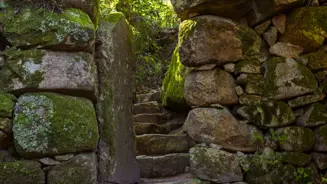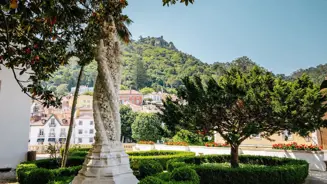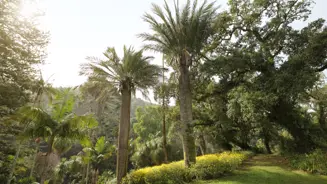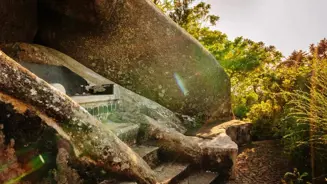Sintra: 4 wonderful places that don't appear on Instagram
04 Apr 2023
Construction of the National Palace of Sintra began between the 10th and 11th centuries, even before the founding of the Kingdom of Portugal. Many monarchs have passed through the palace over the course of four dynasties. Another notable royal palace in the municipality is the National Palace of Queluz, which, after the earthquake of 1755, became the official residence of the Court until it left for Brazil during the French invasions. In Sintra, yet another palace inhabited by kings and queens was the National Palace of Pena. This was the favourite intimate refuge of the Royal Family, who enjoyed the cool weather and the quiet of the Sintra hills, away from the court.
So how many kings passed through these three palaces in Sintra in the end? The answer is simple: all of them! There are records that prove the passage of all monarchs through Sintra, even those of the Philippine dynasty, but some left their mark more than others. Here are some examples:
King Afonso Henriques: soon after the conquest of Lisbon in 1147 and the surrender of the Moors in Sintra, the first king of Portugal had a religious structure built that we know today as the Church of São Pedro de Canaferrim. It was also around this time – specifically in 1154 – that King Afonso Henriques granted Sintra a town charter. It was the first municipality to receive such a charter from the king.
King Dinis: as already mentioned, the construction of the Palace of Sintra began even before the foundation of Portugal, but the truth is that the first document attesting to the existence of a palace in Chão da Oliva, as the place was called, dates from 1281. It is a contract between King Dinis and the free Muslims of Colares, in which the king offered to reduce their tax burden in return for them taking care of the palace's upkeep.
Queen Isabel of Aragon: the palace, the town of Sintra and its territory were granted to the wife of King Dinis in 1287. While the property remained in the hands of the crown, the queen became the beneficiary, taking receipt of all income and tax revenues. Thus began the tradition of giving control of Sintra to the kingdom's queens. It was also Isabel who implemented the cult of the Divine Holy Spirit in Sintra. Even today, we find several churches, chapels and festivals dedicated to the Holy Spirit throughout the municipality.
King João I: it was in the Palace of Sintra – a building to which he devoted his greatest attention, ordering one of the largest interventions ever in the palace – that in 1413 the king received the spies sent to the court of Sicily on a supposed diplomatic mission, but whose real purpose was to obtain strategic data on the port of Ceuta. Don't forget that the conquest of this city symbolically marked the beginning of the Portuguese Discoveries.
King Duarte: from the 15th century onwards, Portuguese monarchs began to use the Palace of Sintra with greater frequency. One of the great lovers of this town was King Duarte, who wrote the following: "We come to this town of Sintra many times to have some summers. And so we believe that the kings who come after us will do too, because we find the land of very good airs and waters, and of counties in which there is a great abundance of provisions from the sea and land, and because our very noble and loyal city of Lisbon is so close, and because we have in Sintra a lot of amusement and recreation in the mountains and hunting. And because we have there noble palaces of very wide views."
King Afonso V: the son of King Duarte was born (1432) and died (1481) in the National Palace of Sintra.
King João II: the son of King Afonso V was acclaimed king of Portugal in the Palace of Sintra.
King Manuel I: This king was responsible for some of the most striking changes to the Palace, namely the implementation of Hispano-Moorish tile coverings and the creation of the Room of the Coat of Arms. At the end of his reign, the Palace of Sintra was one of the grandest palaces of the kings of Portugal. And it was precisely in Sintra, in 1501, that King Manuel learnt of one of the great achievements that marked his reign: the discovery of Brazil.
King Philip I (II of Spain): during his stay in Sintra, after visiting the Convent of the Capuchos for the first time in 1581, Philip sent a letter to his daughters that illustrates well what he felt when he arrived at this refuge of the Franciscan friars, 'hidden' in the Sintra hills. "Of all my kingdoms, there are two places that I greatly esteem, Escorial for being so rich, and the Convent of Santa Cruz [known today as the Convent of the Capuchos] for being so poor," wrote the monarch.
King Afonso VI: This is one of the kings probably most associated with Sintra, for the worst of reasons. King Afonso VI was removed from the throne by his brother, the future Pedro II, who claimed that his brother was physically and mentally unfit. After a period of isolation on Terceira Island in the Azores, the deposed king was sent to the Palace of Sintra, where he died after nine years in confinement. It is said that the marks on the floor of the small room where the king was locked up were made by him pacing repeatedly around. Fact or fiction? The answer is here.

Forest around the Convent of the Capuchos:
Here you can experience the true magic of the Sintra Mountains. In this small forest, you can find a rare example of the primeval forest of the mountains, with old oaks, cork trees, holly, tree-sized boxwoods, strawberry trees, chestnut trees, hazel trees, and many other native species. You will also find the hermitages of Ecce Homo and of the Crucifixion, as well as a viewpoint from which you can contemplate the mountains

Preta Garden, at the National Palace of Sintra:
Have you heard about this garden? Its name, ‘Black Garden’ in English, is derived from a painted composition representing a black washerwoman, accompanied by a male figure in a red livery. Names aside, here you can rest, take good pictures and enjoy the historic centre of Sintra in peace. And, of course, if you look up, you’ll see the imposing Moorish Castle at the top of the mountains.

Mexican Garden, in the Park of Monserrate:
When photos of Monserrate Park appear on social media, we (almost) always see images of the large lawn, the ruins or Beckford's waterfall, but there are many other stunning corners! The Mexican Garden is the only south-facing slope in the park, and you can find many exotic species from dry climates, ponds and lakes, one of which forms the ‘border’ with the lawn. There is so much scenery here that it’s possible to make an inspiring reel in this area of the Park.

St. Catherine's Heights, in the Park of Pena:
It’s in this area of the park that we find a viewpoint with one of the most beautiful views over the Pena Palace. There is a seat here carved into the rock, coated with tar (a substance that was quite the novelty in the 17th century) and decorated with tiles. Known as the Queen's Throne, because it was one of the favourite places of Queen Amélia, it was where she painted one of her best known watercolours of the Pena Palace. It's the perfect place to rest, charge your batteries, enjoy the view and, of course, take amazing pictures.
